The most burning question by just about everyone who has a Google Ads account – “When should I use automated bidding?”
Automated bidding is a hot topic in our industry. There are always articles talking about the need to use automated bidding, quickly answered by posts warning you should never automate your bidding
When it comes down to it, the real answer isn’t so simple: it depends.
There are a variety of automated bidding options in Google Ads. Some may be great for your account, but others might be terrible. You might find you have a use for every bidding strategy somewhere in your account, or you might not be able to use any. Until you understand how each bidding strategy works, this is impossible to determine.
In this guide to automating your bidding strategy, I’ll walk through each of the options available to you, and I’ll point out what you need to watch out for with automation.
Let’s start off where every new account starts: manual bidding.
Manual Bidding
Manual bidding is the easiest bid strategy to grasp on the Google Ads platform. Advertisers set their bids manually at the keyword level, and the bids stay where they are until the advertiser changes them.
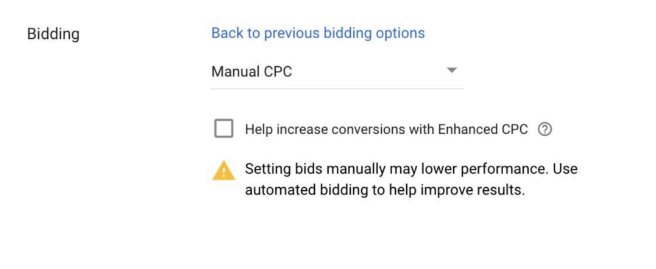
Despite the friendly warning from Google, this is the best place to start for folks starting out in PPC or using their spare time to manage their account but has its drawbacks.
Cautions for Manual Bidding
First, it can take precious time away from other tasks. When it comes down to it, manual bidding still requires a time investment to look at performance, judge if the keyword bid needs to change, decide what that change needs to be and then actually making that change.
Second, manual bidding can be underinformed. When advertisers review performance metrics, we’re at the whim of the metrics Google allows us to see for our campaigns.
With automated bidding strategies, Google is able to take data points into account that we don’t even know exist.
These two downsides don’t mean all automation is good and that manual bidding isn’t the right solution for you. But these are something to consider when determining bid strategies.
If you’re interested in moving away from manual bidding to save time and leverage additional data points, here is a rundown of the automated bidding strategies Google Ads has to offer.
Enhanced CPC
Enhanced CPC bidding is very similar to manual bidding but allows the Google Ads algorithm to make adjustments to the manually set keyword bid.
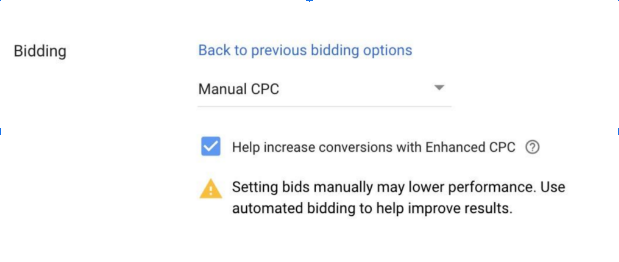
You can enable Enhanced CPC by simply checking the box below the manual bidding setting or choosing Enhanced CPC from the bidding type dropdown.
With Enhanced CPC, Google Ads will increase or decrease a bid for a keyword in an individual auction based on the likelihood that a click will lead to a sale. This change used to be limited to a 30% adjustment up or down, but that cap has been removed in recent years and now gives Google Ads the ability to adjust to any level.
The most common outcomes of successful use of Enhanced CPC are increased click-through rate (CTR) and conversion rate (CVR). Typically, there is also an increase in cost per click (CPC), as the algorithm tends to raise the bid more often than it lowers it.
Cautions for Enhanced CPC
Since Enhanced CPC can adjust keyword bids with no caps in place, there is a chance the bids and resulting CPCs could be much higher than what is profitable for the account. The goal of this bid type is to increase the likelihood of a conversion, but not necessarily at the target cost per conversion (CPA), you have in mind.
Test Enhanced CPC as the first step into automation beyond manual bidding if your account is performing well. Keep an eye on CTR and CVR to see if the bidding strategy is functioning as expected (both should go up) but also track CPC and CPA to ensure the results are still profitable.
Maximize Conversions
Unlike Enhanced CPC, Maximize Conversions is what Google calls a fully automated bidding strategy. This means there are no individual keyword bids set by advertisers that Google factors in. It simply chooses a CPC bid based on the goal outcome of the bidding strategy.

The Maximum Conversions bid strategy is designed to get as many conversions as possible while spending your daily budget. There are no additional settings for the advertiser to control like we’ll see in future options. It’s important that each campaign using Maximize Conversions has their own daily budget assigned and not be part of a shared budget as this strategy will always try and spend the full daily allotted budget per campaign. If included in a shared budget, Maximize Conversions will spend the daily budget of the entire shared group, not just its own allotment.
Cautions for Maximize Conversions
Although this bid strategy is relatively straightforward, it warrants an abundance of caution.
First, do not run this strategy without having conversion tracking in place. Google’s goal is to maximize the number of conversions being tracked, so if no tracking is enabled, the algorithm is more likely to make bad decisions to find a person willing to convert.
Second, if you have any sort of goals around profitability, this is a dangerous bidding strategy to leverage. Since Google is always going to spend the full daily budget regardless of conversion performance, the end profitability of the campaign on any given day may be great or disastrous.
If you have goals for profitability or efficiency, I highly suggest you utilize one of the two bidding strategies below: Target CPA or Target ROAS.
Target CPA
Target CPA (cost per acquisition) is a fully automated bid strategy where advertisers set a target cost per conversion, and then Google adjusts bids to generate as many conversions as possible at that CPA.
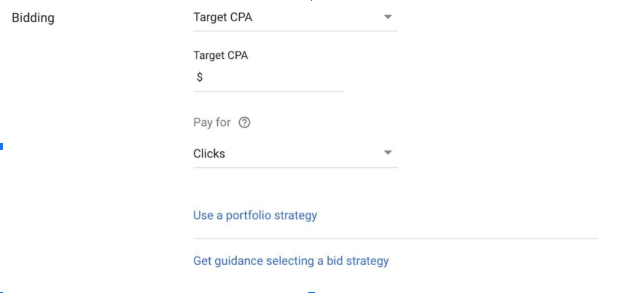
Individual conversions through this bidding strategy may have CPAs above or below your Target CPA, but Google will try to balance out over time to your Target CPA.
Target CPA can be set at either the campaign or portfolio level, which means there will be no individual keyword level bids for you to adjust.
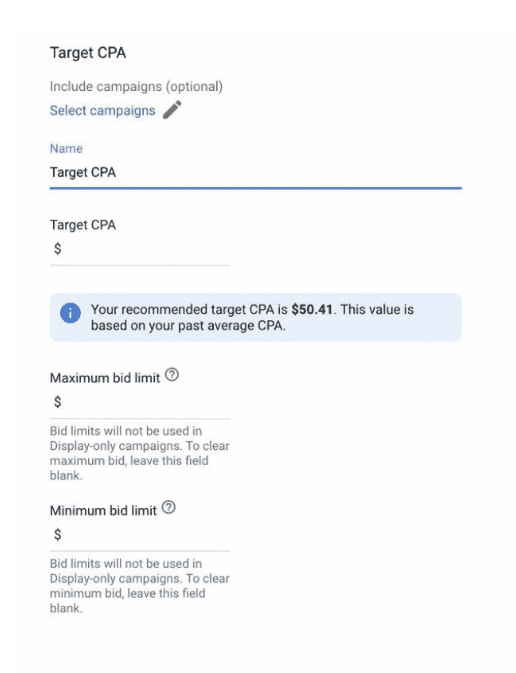
Advertisers are able to set bid minimums and maximums to ensure Google doesn’t adjust bids through the floor or ceiling but only for portfolio level use. If you’re targeting for individual campaigns, these bid caps aren’t available.
Cautions for Target CPA
Like Maximize Conversions, Target CPA bidding requires conversion tracking enabled in your account. Without it, this bidding strategy is useless – it will never know if it’s driving conversions or not.
But that’s not all.
Just because you have conversion tracking turned on doesn’t mean you’re off to the races just yet.
To drive conversion performance, Google needs to have a certain amount of conversion data to be able to make smart decisions. If you don’t have enough conversion volume, then the algorithm can’t make smart decisions and target CPA isn’t the right bidding option for you.
At the campaign level, Google says the minimum is 15 conversions in the last 30 days, but we’ve found this to be on the low side.
Ideally, you should have at least 30 conversions, if not 50, in the past 30 days before testing Target CPA bidding. If your campaigns don’t reach this level individually, they might at a portfolio level. If they still don’t, Target CPA likely shouldn’t be on your list of eligible bid strategies.
Lastly, when getting started with Target CPA, it’s important to set realistic initial goals. If your campaign has had an average CPA of $40 over the past six months, it’s not in your best interest to set a Target CPA of $20, as it will limit Google right away in the auctions it can enter in and learn.
If you’re planning to use Target CPA bidding, plan on the first two weeks a month being a learning phase. Set your Target CPA slightly higher than what your average CPA has been recently or use the Google suggested CPA target to let Google find a groove, then slowly bring it down over time to your Target CPA.
Target ROAS
This is nearly the same as Target CPA, but with return on ad spend (ROAS) instead. With this strategy, Google Ads will predict future conversion and conversion value performance based on your historical data to enter auctions. It will adjust bids in real time to maximize conversion value while trying to achieve the Target ROAS goal you’ve set at the ad group, campaign, or portfolio level.
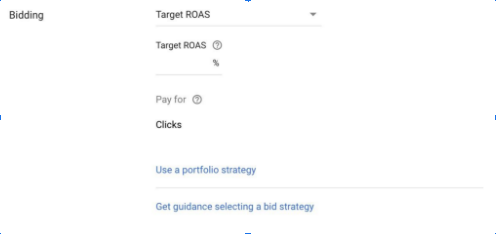
As with Target CPA, individual conversions may have higher or lower ROAS than your goal, and Google will work to balance those out to achieve your ROAS target.
With Target ROAS, advertisers can set bid limits (minimums and maximums) at the campaign or portfolio level to help keep the Google algorithm from straying too far, but Google cautions against this as it can limit the machine decision making.
Cautions for Target ROAS
All the same cautions for Target CPA apply to Target ROAS. Ensure you have accurate conversion tracking in place including conversion values and that you have enough conversion performance in the recent past to leverage this strategy.
Also, be careful not set your Target ROAS at a restrictively high level right off the bat. Start off with a goal slightly lower than what your performance has been recently, then slowly raise the target over time to achieve a more profitable ROAS.
Maximize Clicks
This strategy is very similar to Maximize Conversions but instead focuses on clicks. With Maximize Clicks, Google will work to get as many clicks as possible while spending your daily budget. This strategy can be great if you’re trying to drive more volume to your site for branding and list building, or if you have very strong conversion performance and want to find more volume.
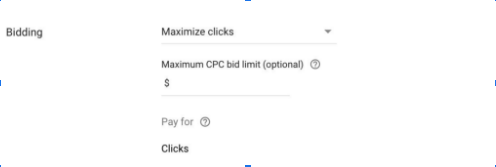
Advertisers can set a max CPC limit to help keep CPCs down while Google spends the daily budget.
Cautions with Maximize Clicks
Always set a max CPC and keep an eye on your average max CPC, as well. Google will work to get as many clicks as possible for your campaign, but, as with Maximize Conversions, it will also work hard to spend your entire daily budget each day, even if clicks are far more expensive than normal. Regularly check in on the CPC performance this bid strategy is generating (and any other goal metrics you have in place) to ensure it’s still meeting your goals. If not, then adjust your settings or potentially look to a new bid strategy.
Target Impression Share
Target Impression Share is a newer bidding strategy as of the writing of this post. It only recently came out of beta. With Target Impression Share, advertisers set a goal Impression Share percentage in the same way you set a Target CPA for that bidding strategy.

There are three placement options you have to bid for with Target Impression Share:
- Absolute Top of Page
- Top of Page
- Anywhere on the Page
Each of these will tell the Google algorithm different things about your preferences, and it will adjust bids accordingly.
Advertisers are also able to set a max CPC bid with Target Impression Share bidding to help guard against over spend, but Google cautions against setting it too low and throttling performance.
Cautions for Target Impression Share
Like any other bidding strategy, this one has the potential to increase your bids beyond profitability level if you’re not careful. This strategy is focused on awareness and reach (though it can be used for performance), but there are still limits to what makes sense monetarily for your campaigns.
Always set a max CPC bid to ensure you don’t pay too much for any individual click. Although Google cautions against it, don’t worry about setting this bid too low to start. Try setting it at a percentage increase over your current bid of 20%-50%. If that works well, then leave that cap. If you’re not seeing the volume you’d like, increase the max CPC.
Very few auctions will actually see 100% coverage anymore. So although you set a target to 100%, don’t be surprised or frustrated if you show up closer to 95% as a top achievable number.
Always keep an eye on CPCs and performance outcomes to ensure this bidding strategy is achieving your goals before continuing with this strategy.
Target Search Page Location
Target Search Page Location is a portfolio only bidding strategy that allows advertisers to have their ads shown at the top of the search results or on the first page of results.
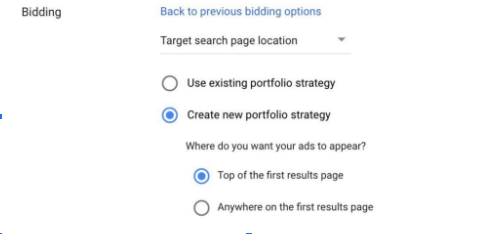
This is perfect for those in competitive spaces bidding on vanity terms that have different KPIs than other keywords in the account.
Settings will allow adjustments for top-of-page or first-page views, bid automation, manual CPC bid limits, as well as a low-quality keyword setting. This low-quality keyword setting allows you to exclude keywords with Quality Scores less than four, as raising their bids to achieve a certain page position can make for greater impact than keywords with higher quality scores due to ad rank calculations.
Cautions for Target Search Page Location
This strategy is designed to gain ad impressions in a given location on the results page, but it does not focus on any profitability or performance numbers for your account. Although showing up at the top or on the first page of the search page results may be important to you, if your ads have CPCs or CPAs that are too high in those positions, it may make sense to choose a different strategy.
Target Outranking Share
Target Outranking Share is similar to Target Search Page Location in that it focuses on the placement of an ad in an auction rather than the actual outcomes of that placement (CPCs, CTR, CPA, etc.). Target Outranking Share is designed to help advertisers rank higher in search results than another domain, typically a key competitor.
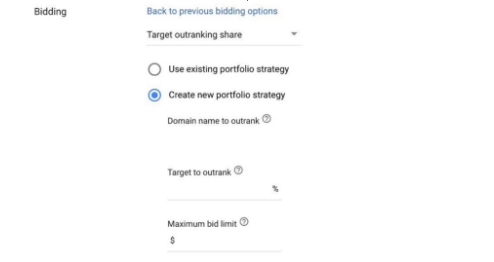
With Target Outranking Share, you designate the domain you want to outrank and then the percentage share of auctions that you want to outrank them for. It’s important to note that this strategy may or may not see a rise in overall ad rank, as it’s only focused on one other domain, not all domains in the auction.
Cautions for Target Outranking Share
Target Outranking Share has all the precautions that come with Target Search Page Location, but it also has another layer: competition.
Similar to bidding on a competitor’s brand name, using Target Outranking Share could cause a bidding war between you and the domain you’ve targeted if they also want to outrank you. This type of bidding war can drive up the CPCs for both of you, potentially making the resulting ad impressions unprofitable. The only winner in this bidding war scenario is Google, which will generate more revenue per click and your CPCs rise.
Cost per Thousand Viewable Impressions (vCPM)
Formerly cost per thousand impressions (CPM), vCPM bidding is a display only bid strategy designed to let advertisers bid for impressions when your ad is shown in a viewable space.

A key factor for this strategy is the definition of “viewability.” According to Google:
An ad is counted as “viewable” when 50 per cent of your ad shows on screen for one second or longer for display ads, and two seconds or longer for video ads.
vCPM bidding is great if you’re working on expanding your brand coverage and simply want to get your message in front of a large group of people.
Cautions for Cost per thousand Viewable Impressions
There are a couple of things to watch out for with vCPM bidding: frequency and placements.
With this strategy, Google will look to maximize the number of viewable impressions your ad receives. When using this strategy with a finite audience, your chances of hitting a high-frequency count for each user go up.
We’ve all had the ads that seem to stalk us as we peruse the internet, so be sure that although you’re trying to maximize ad views, you’re not doing it at the expense of a small audience who now feel overwhelmed by your brand.
Additionally, not all viewable impressions are created equal. Just like any other display campaign, it’s important to keep an eye on your placements report to ensure you’re not showing up on unwanted sites.
So, when should you use automated bidding?
Now that we’ve covered all the automated bid strategies, it’s time to choose the one that’s right for your whole account, right?
Wrong!
The best thing about automated bidding: we can pick and choose what we use where.
Google Ads allows for automated bidding strategies to be set at either the ad group, campaign, or portfolio level, depending on the strategy you choose, so you’re able to direct which aspects of your account rely on bid strategies that complement their goals.
When choosing a bid strategy, evaluate at the campaign level to determine if the strategy will help accomplish your goal and if you have enough data to make it work (e.g., enough conversion volume to make Target CPA effective). If not, you might benefit from another bid strategy, a portfolio level strategy, or even an adjustment in account structure to better leverage it later on.
In Conclusion: Use automated bidding with caution
Automated bid strategies in Google Ads are a fantastic way to save time while leveraging algorithms to optimize an account, but only when evaluated and chosen wisely.
Each of the three strategies we’ve talked about in this series – bidding, ads and keywords, or automated rules – can have its place in any account, but only if it’s the right fit. They’re not a one-size-fits-all solution, but there’s also no excuse for “set it and forget it.” Once these strategies are being leveraged in an account, set a reminder to check in on them to ensure they’re still accomplishing the goals they set out to hit. Happy automating!





